Last Chance to Catch NYC's Holiday Notalgia Train
We met the voices of the NYC subway on our nostalgia ride this weekend!


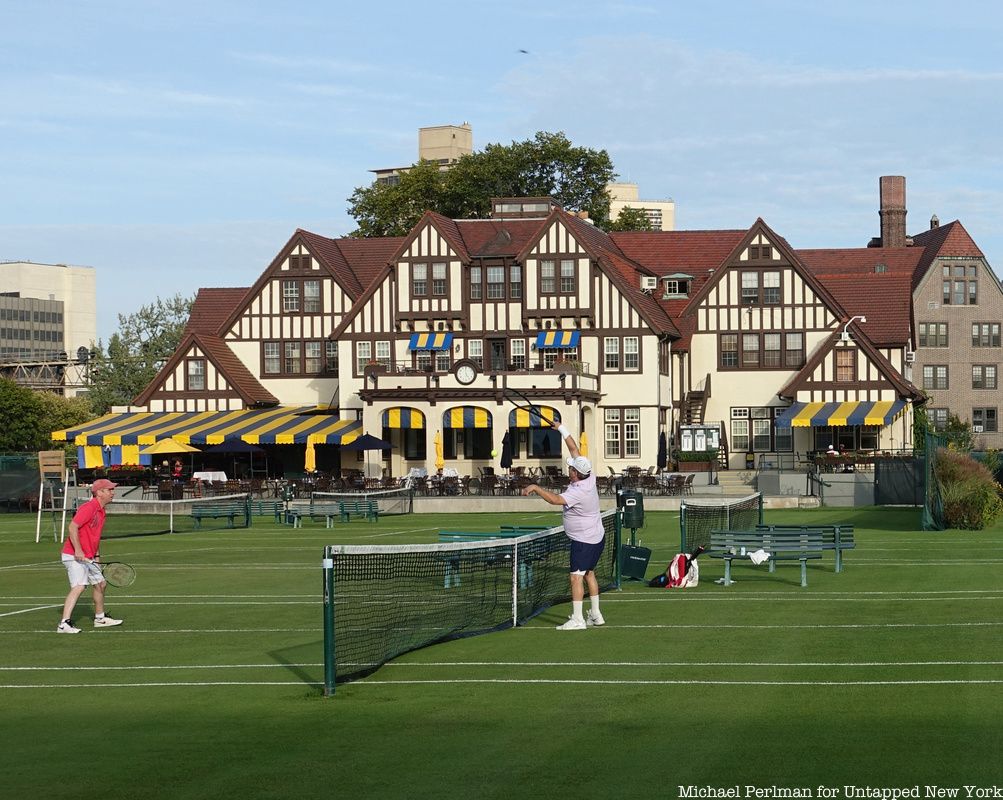
With over 88,000 residents, a unique historical legacy, classic old-time restaurants, and copious pop culture references, Forest Hills, Queens offers a lot to discover. As visitors walk down its vast avenues and quaint side streets, they are struck by the area’s breathtaking architecture. While beautiful on the outside, the neighborhood also has much hidden beneath its surface ready for discovery. Read to learn more about what makes Forest Hills such an integral and fascinating neighborhood in Queens.

Before the Forest Hills we know today—bounded by burgeoning hipster restaurants along Austin Street and brimming with architectural wonders in Forest Hills Garden—the area was once a simple farming community named Whitepot, which consisted mainly of wood-frame farmhouses and fields of crops. Around 1653, the Township of Newton was established by British and Dutch settlers, with Whitepot being one of its sections. It consisted of six farms named after Ascan Backus (who names Ascan Avenue), Casper-Joost Springsteen, Horatio N. Squire, Abram V.S. Lott, Sarah V. Bolmer, and James Van Siclen. Their farms greatly benefited the city’s supplies, providing hay, grains, vegetables, fruits, nuts, and many more items to New York’s markets.
The area remained relatively small over the years, being cited by the New York Times as having 30 residents in 1900 who were mostly German celery and potato planters. In 1906, the Cord Meyer Development Company purchased 600 acres of the Hopedale section of Whitepot—the area of land bounded by Queens Boulevard and Union Turnpike. The company used the land to form Forest Hills, renaming it for its high elevation and proximity to Forest Park. Today, the only known remnant of Whitepot is the Remsen Cemetery which contains tombstones from 1790 through 1819.
Interestingly, there was controversy surrounding the area’s original name in the early 20th century, with certain individuals debating that it was Whiteput instead. Some believed that the name Whitepot referred to the legend of the land having originally been purchased from the Native Americans with an exchange of three clay white pots. However, many have refuted this as being the original source name, claiming that the authentic spelling was Whiteput after the Dutch term “put,” which is a stream that becomes a hollow pit. Currently, it is believed that the area was called Whiteput by the original Dutch settlers, but the name was later anglicized by the English to Whitepot.
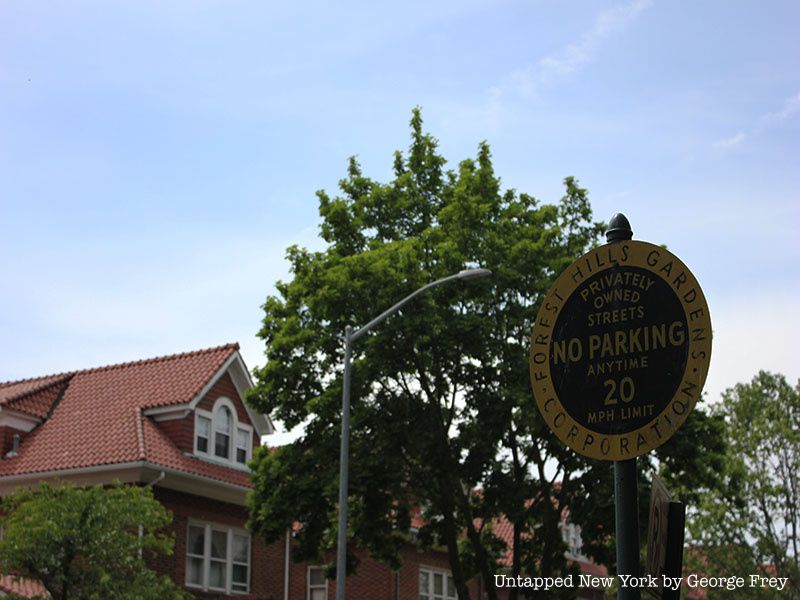
During the early years following the establishment of Forest Hills, many of its streets had a wide and eclectic range of alphabetical names that over time have been replaced by more common numerical names. One of the first street names that changed was Roman Avenue, located between Queens Boulevard and Austin Street. Today it is known as 72nd Avenue, with the only section of its name preserved in the Forest Hills Garden enclave. In fact, the enclave is the only section of the neighborhood that still fully recognizes all of its original street names.
Many of the neighborhood’s changed street names are located south of Austin Street leading to Metropolitan Avenue and include the streets of DeKoven, Pilgrim, and Zuni, now 72nd Road, 67th Drive, and 63rd Drive respectively. Others include streets that were originally named to reflect the area’s farming practices. These included the streets of Sample, Quality, and Harvest, which are now 66th Road, 67th Road, and 70th Road respectively. However, not all of the neighborhood’s original street names have been changed, with much of its thoroughfares retaining their authenticity. Some of the most important which still remain are Yellowstone Boulevard and Metropolitan Avenue.
Moreover, remnants of these forgotten street names exist in buildings across the neighborhood, which were named after their street’s original alphabetical name. These buildings and many others were named by the Cord Meyer Development Company, which has played a crucial role in Forest Hills’ development since its founding. Some examples include the apartment houses The Kelvin, now located on 69th Road, and The Livingston, now on 69th Avenue.
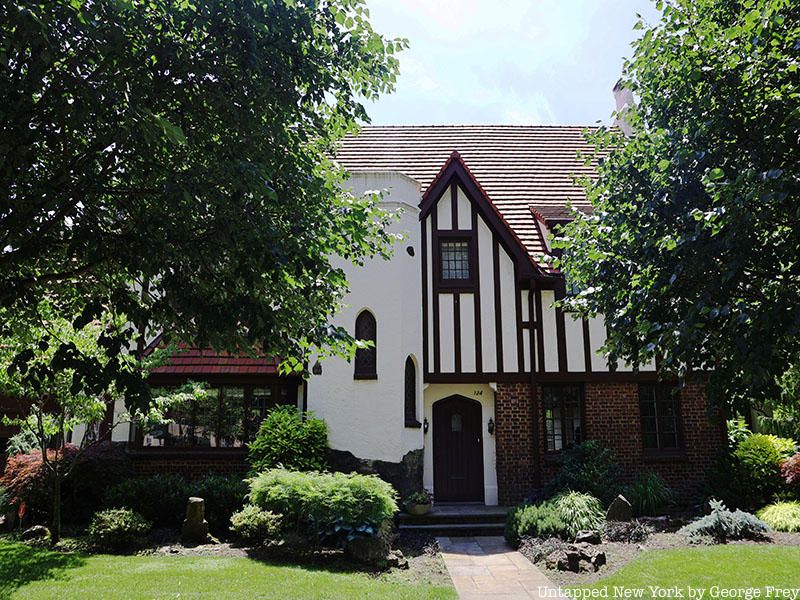
Located within the neighborhood of Forest Hills, Forest Hills Garden is one of the most beautiful and oldest of America’s planned communities. Specifically, the enclave occupies a 175-acre wedge and is located south of the Forest Hills LIRR station. Around 4,500 residents call Forest Hills Garden home, comprising over 800 houses, 11 apartment buildings, and an assortment of churches, restaurants, parks, and storefronts. Currently, it is managed by the Forest Hills Garden Corporation, which is run by the area’s property owners.
Forest Hills Garden was first established in 1909 when Margaret Sage, founder of the Russell Sage Foundation, bought 142 acres of Forest Hills from the Cord Meyer Development Company. Architects Grosvenor Atterbury and Frederick Law Olmsted, Jr. were commissioned to plan and design the new town. They chose to model Forest Hills Gardens’ architecture directly after English garden cities of the early 20th century, giving the enclave a nostalgic and rustic charm. These garden cities—first popularized by theorist Sir Ebenezer Howard in 1891—were intended to be closed communities of working-class people surrounded by “green belts,” which would contain proportionate zones for agriculture, homes, and industry.
Throughout the neighborhood, visitors can find large Tudor homes fitted with the style’s typical boast towers, spires, Norman-inspired turrets, gabled roofs, and mullioned windows. Other additions to the enclave that help to give it a decidedly English appearance are its wrought-iron street lamps and sloping, curved streets containing nautical blue-hued street signs. Other nearby communities modeled after garden cities include Sunnyside and Jackson Heights, both in Queens.
Forest Hills Garden has maintained its distinctive style amid the bustling and modernizing city as a result of a covenant created in 1913. The covenant intended to ensure that the community remained an idyllic slice of country life in the heart of New York City’s growing industrial landscape. Specifically, the covenant puts limits on industry and prevents exterior alterations to the homes without approval, which has greatly aided in preserving the community’s historic style over the past 100 years. Moreover, the covenant has never imposed exclusionary economic, racial, or social restrictions on residents interested in moving, with the garden city concept designed to house individuals from different socio-economic strata.
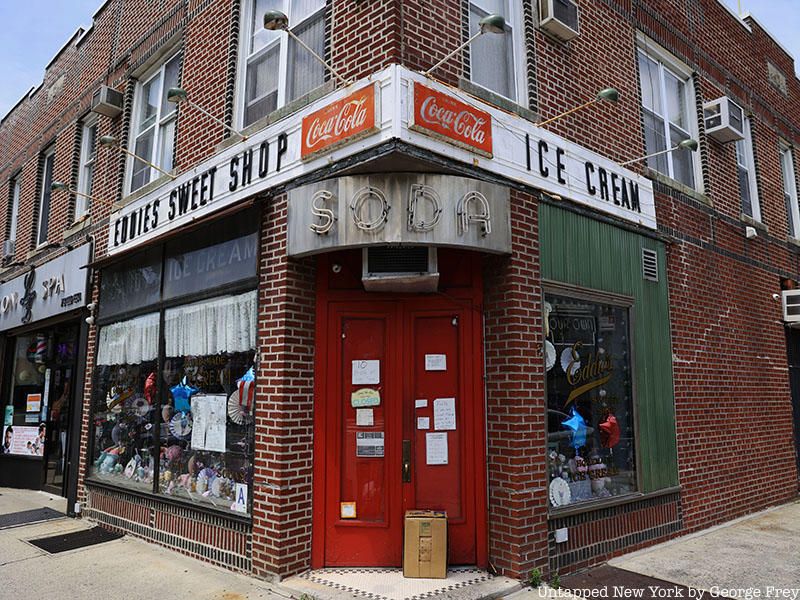
Established in 1925, Eddie’s Sweet Shop is a staple in the Forest Hills community, serving delicious ice cream for all to enjoy. Following the closure of the original Jahn franchise locations, Eddie’s Sweet Shop became the unofficial oldest ice cream parlor in the city. Walking inside the shop, customers are greeted by a blast from the past. The shop’s wooden and marble interior has not been changed since it first opened, giving it an old-fashioned vibe that serves as a nice break from the more modern dessert places across the city. Even its refrigerator is more than 80 years old.
Currently, Eddie’s Sweet Shop is owned by the Citrano family, who purchased the store in 1968. It has a small but still delicious menu, with 18 flavors of ice cream all made from scratch. Similarly, the shop’s topping selection is simple but flavorful, with its whipped cream also being homemade. Some of the shop’s ice cream flavors include classics such as rum raisin and butter pecan or more innovative combinations like pistachio pineapple. This ice cream is used in a number of old-time desserts, such as banana splits, floats, shakes, sundaes, egg creams, and sodas.
The shop is located at 105-29 Metropolitan Ave at 72nd Road. It is cash only and opens on weekdays besides Monday from 1:00 p.m. to 11:30 p.m. and weekends from 12:00 p.m. to 11:30 p.m.
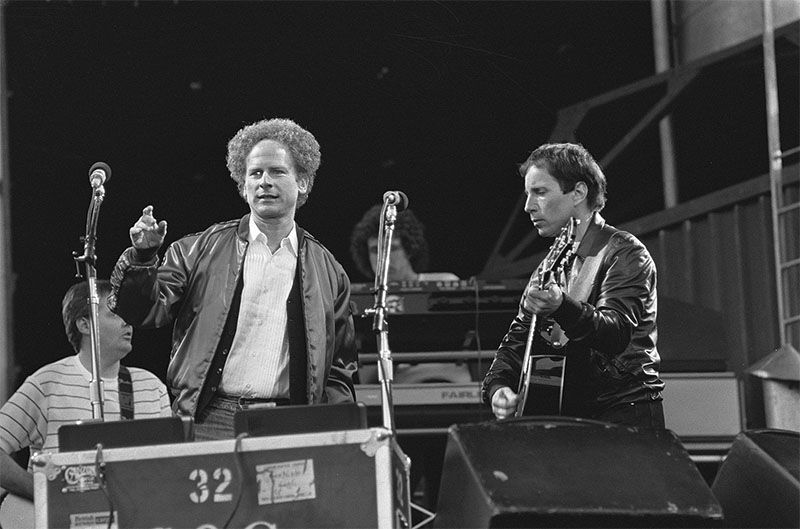
The dynamic duo of the critically acclaimed folk-rock band Simon & Garfunkel both have a shared upbringing around the Forest Hills area. Paul Simon and Art Garfunkel grew up together during the 1940s and 50s in the predominantly Jewish neighborhood of Kew Gardens Hills, three blocks away from each other. Both attended Public School 164 and Parsons Junior High School and would first become friends in 1953 after appearing together in a sixth-grade adaptation of “Alice in Wonderland.” The two spent the following few years learning to harmonize and write songs together, even forming a streetcorner doo-wop group called the Peptones with three other friends.
After matriculating to Forest Hills High School in 1954, Simon and Garfunkel continued to make music. In 1956, while recording their song “Hey Schoolgirl,” the two were overheard by promoter Sid Prosen, who signed them to his independent label Big Records at just 15 years old. Under Big Records, the duo assumed the name Tom & Jerry and received much acclaim for their music, even appearing as the headliners for Dick Clark’s “American Bandstand” alongside Jerry Lee Lewis. Finally, the duo released two more singles, “Our Song” and “That’s My Story,” though to less acclaim. Impressively, the two accomplished all of this while still being full-time students at Forest Hills High School, from which they graduated in 1958.
However, Simon and Garfunkel’s connections to Forest Hills did not end after high school. Both returned numerous times to the neighborhood to perform at Forest Hills Stadium, gracing the stage in 1966, 1967, 1968, and for two nights in 1971 for their final official concert together as a band. More recently, Paul Simon has performed solo at the stadium in 2016 and gave the final concert of his Homeward Bound farewell tour right in the heart of his home community at Flushing Meadows Corona Park in 2018.

New York City is one of the key locations used for much of the action in Marvel Comics, serving as the traditional home of the Avengers, the Fantastic Four, Doctor Strange, Jessica Jones, and countless other characters. For Spider-Man—everybody’s friendly neighborhood superhero—his home can be found in the heart of Queens. Throughout the comics, Spider-man lives with his Aunt May and Uncle Ben at 20 Ingram Street, a two-story boarding house in Forest Hills Gardens. In real life, 20 Ingram Street is less modest and plain as it is portrayed in the comics, instead fashioned in the style of Edwardian and English garden houses.
Coincidentally, a real-life Parker family actually lived at 20 Ingram Street. In 1974, Andrew and Suzane Parker along with their two daughters moved into the residence. A few years later in 1989, the family reported that they began receiving junk mail addressed to Peter Parker, after their address was listed as the superhero’s home in the June and July 1989 issues of “The Amazing Spider-Man.” Originally, the character was created by Stan Lee in 1962 as a Forest Hills resident, but his official address was never pinpointed by the comic book legend, instead being added years later by writer David Michelinie.
However, it would not be until the family was told by a reporter from the “Queens Tribune” during the summer of 2001 that they realized how their lives shockingly mirrored that of one of Marvel’s most notable characters. Besides sharing a last name with Peter Parker, they also discovered another intriguing connection to the Spider-man comics. One of Andrew and Suzanne’s longtime neighbors of more than 20 years was Terri Osborne, whose last name was almost identical to that of Spider-Man’s biggest enemy, the Green Goblin, which is the alias of Norman Osborn.
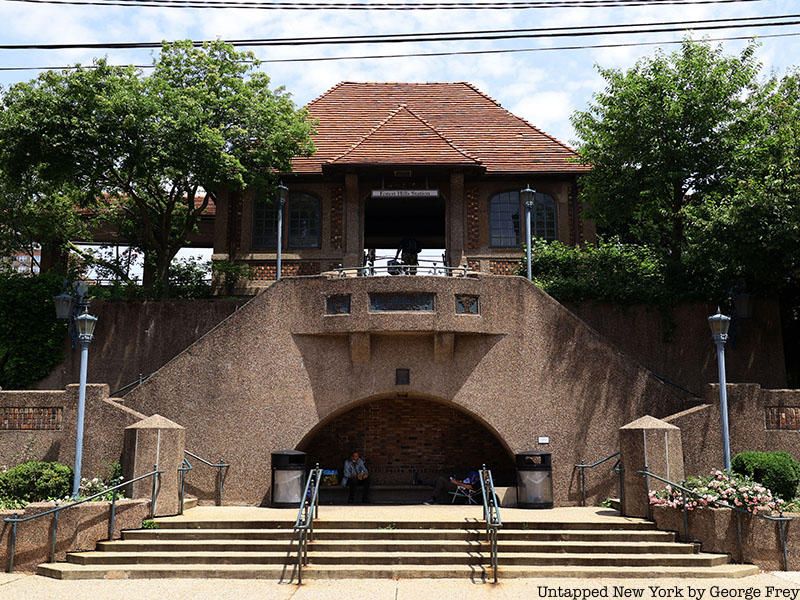
One winter night in January of 1977, a gruesome murder took place near Station Square, a beautiful brick-paved open space modeled on a medieval town center located down 71st Avenue in Forest Hills Garden. With its gorgeous archways and surrounding brick buildings, one would think the idyllic nature of Station Square could never be touched. However, as John Diel and Christine Freund sat together at the station while on a date, three .44 caliber shells smashed into the windshield of Diel’s car. Though Diel survived, Freund was hit twice and passed away shortly after. Berkowitz also murdered Forest Hills resident Virginia Voskerichian as she was heading to her Exeter Street home.
The murder was perpetrated by David Berkowitz, a serial killer known as Son of Sam and the “.44 Caliber King.” From mid-1976 to July 1977, Berkowitz killed six people and wounded seven others. During this time, Berkowitz was able to elude the police during one of the city’s largest manhunts. He even left letters mocking the police and promised further crimes. Eventually, he was captured on August 10, 1977, ending a killing spree that had greatly terrorized the city’s public. Berkowitz would go on to confess to all of his crimes, citing that he had acted at the behest of a demon manifested in the form of a neighbor’s dog named Sam—though he would state years later that the demon had been a lie.

Though the U.S. Tennis Open is currently held in Flushing Meadows Corona Park at the USTA Billie Jean King National Tennis Center, it once took place just a few miles away in Forest Hills at the West Side Tennis Club. Founded in 1892, the West Side Tennis Club’s original 13 members first rented land on Central Park West that contained three clay courts and a small clubhouse. However, this soon became too expensive and ten years later in 1902, the club moved uptown to land near Columbia University before making its way across the city to Forest Hills in 1912, after a committee voted to purchase a 10-acre plot in the area. The club’s Tudor-style clubhouse and fields were officially finished being constructed in 1914.
The U.S. National Championship (later renamed the U.S. Tennis Open in 1968) is the oldest tennis championship in the world, first beginning in Newport, Rhode Island in August 1881. A few years later in 1915, the National Championship would move to the West Side Tennis Club after a group of 100 tennis players signed a petition in favor. They argued that as most tennis clubs and fans were located in New York City, it was the most logical choice to officially move the championship there. However, the move was opposed by a group of eight former national champions and the issue was brought to a vote in February 1915 at the annual USNLTA meeting. The final verdict came to be 129 in favor versus 119 against the move.
From this point on, the West Side Tennis Club would serve as the official location for 60 U.S. Open Championships, first from 1915-1920, and then again from 1924-1977. The club would end its run as the purveyor of the country’s premier tennis competition in 1978 upon the opening of the USTA National Tennis Center. Housing the Forest Hills Stadium, the West Side Tennis Club is currently used today mainly as an outdoor concert venue. Some notable performers who have performed at the stadium include The Beatles, Bob Dylan, and The Rolling Stones.
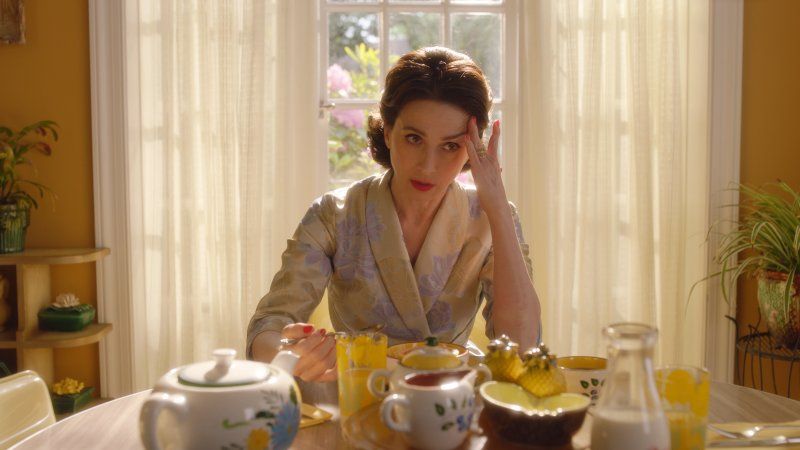
Some of the most iconic films and television shows have been shot throughout Forest Hills. One such example is Wes Anderson’s 2001 film “The Royal Tenenbaums” which was partially shot in Forest Hills. During one of the film’s most poignant scenes situated on the Center Court of the West Side Tennis Club, pro tennis player Richie Tenenbaum plays a disastrous final match which sends his career up in flames.
Another influential film produced in Forest Hills is Alfred Hitchcock’s 1951 film “Strangers On A Train,” with one of the film’s most famous scenes also taking place right at the West Side Tennis Club. Background footage of the 1950 Davis Cup finals held August 25-27 was also used in the film. In addition, recent television shows like “The Marvelous Mrs. Maisel” have used Forest Hills as a prime background for their actors. During the show’s third season, Rose, Abe, and Zelda move in together with the parents of Joel Maisel, with their new abode being located on a private street off Ascan Avenue.
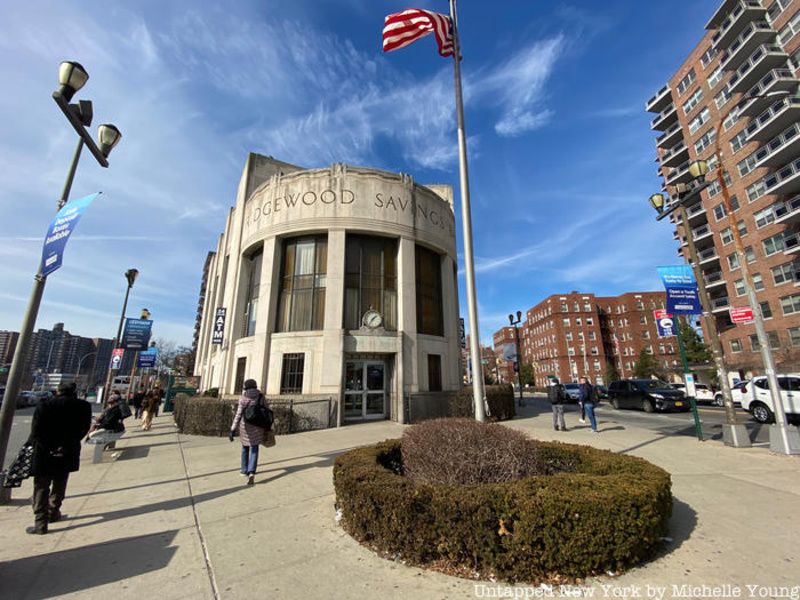
The Ridgewood Savings Bank is currently the largest mutual savings bank in all of New York State. Founded in 1921 in Ridgewood, Queens, the bank today is worth $4.6 billion and operates 35 branches across New York City, Long Island, and Westchester County. Located in Forest Hills at 107-55 Queens Boulevard, the bank’s first branch opened its doors in 1940. Stepping inside, visitors can see that much of its architecture has been carefully preserved, with its copper-colored teller booths and stained glass windows harkening to the past. Designated as a New York City landmark in 2000, the Forest Hills Ridgewood Savings Bank continues to remain one of the bank’s premier and culturally significant branches.
Next, check out Untapped’s Guide to Woodside, Queens: 16 Must-Visit Places!
Subscribe to our newsletter